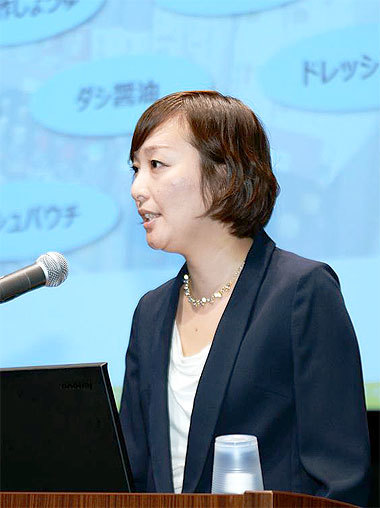Note: This website was automatically translated, so some terms or nuances may not be completely accurate.
[Seminar Report] Video Research Ltd. Proposes New Consumer Segment Analysis
At the "VR SOLUTION SEMINAR Communication Chaos: What Do Consumers Choose Amidst the Flood of Information?" held by Video Research Ltd. in Tokyo on November 26, research presentations and panel discussions explored consumer behavior in today's information-saturated world.
Everyone has their own way of thinking. A new consumer classification to decipher the chaotic world
Naomi Ogata of the company's Consumer Intelligence Department presented "Deciphering Communication Chaos: Simple Thinking, Logical Approach." She introduced a classification of consumer patterns in information acquisition, purchasing, and other choice behaviors, analyzed from their proprietary research findings.
 |
Video Research Ltd. - Ms. Ogata |
Consumers with diversifying lifestyles, media with exploding information volumes, and increasingly fragmented and diverse products. Ogata described this modern society as "chaotic."
In this chaotic world, consumers unconsciously filter information. They erect "mind barriers" to shut out overwhelming information while allowing specific messages to pass through. Video Research Ltd. termed these passageways "mind holes." These mind holes vary by individual, but consumers each have distinct "thinking habits" that influence their behavior.
Video Research Ltd. quantitatively analyzed consumer tendencies regarding information acquisition (stimuli) and choices like purchasing (responses). Through group interviews, they classified consumers into six types based on these thinking patterns. This classification applies across categories. Mr. Ogata describes it as "a method for simplifying thoughts in our chaotic modern world."
According to the survey results, information first circulates from self-initiated sources to externally influenced groups. Similarly, the flow of choice also moves from self-initiated to externally influenced within a short period. Based on this, consumers' thinking patterns were classified into "information × choice segments" using two axes: their tendency to disseminate information ("self-initiated" / "externally influenced") and the points they prioritize when making purchasing choices ("image" / "function"). Consumers were then categorized into the following six types:
|
● Trend Freaks: Spontaneous information sharing, image-focused. |

Mr. Ogata states that classifying consumers by "information × choice segments" reveals which media and messages most easily penetrate their mental barriers. For example, magazines match Trend Freaks as an information input source, while stores suit Natural Low-Involvement types. As communication keywords, "New Release" works for Trend Freaks, while "No. 1 in Sales" resonates with Community Conformists and Stoic Pragmatists.
The communication strategy for last year's popular "air fryer" was introduced as an example. Mr. Ogata analyzed that the massive success stemmed from a logical approach: launching a TV commercial announcing its Japanese debut, providing detailed feature explanations online, promoting it through special in-store displays, and then, after launch, broadcasting TV commercials highlighting its huge popularity while also conducting live demonstrations and tastings at food stalls. This sequential, multi-faceted promotional strategy effectively appealed to all "Information × Choice Segments."
Classification using the "Information × Choice Segment" framework is possible through 18 questions. On the day, seminar participants could determine their own type at a booth. Video Research Ltd. plans to simplify customer classification and provide marketing solutions based on logical approaches informed by these results.
Following this presentation, a session titled "Breaking Through Communication Chaos: For Better Connections with Consumers" was held. Speakers included Hideki Umeya from Panasonic (manufacturer), Megumi Tanaka from Shueisha (magazine media), Mutsumi Fukushi from Nippon Television Network Corporation (TV media), Akira Yamamoto from Keio University Graduate School (researcher), and moderator Yasuyo Kajisa from Video Research Ltd. Each presented new initiatives for the Communication Chaos era from their respective perspectives.
Mr. Fukushi of Nippon TV introduced initiatives aimed at "habituating" television viewing, helping viewers understand when programs matching their preferences air. He also discussed creating easily understandable programs where each show's concept can be expressed in a single line, while striving for content diversification.
Mr. Tanaka of Shueisha noted the shift away from the era where magazines centered on supplements. As a new initiative, he introduced efforts to enrich variations within a single magazine—such as offering versions with or without supplements and different sizes—to give consumers the joy of choice. Furthermore, the company is experimenting with a strategy where editorial teams create content across magazines, web, and social media simultaneously, aiming to deliver high-quality content.
Mr. Umeya of Panasonic introduced the "J Concept" product series, developed through thorough consumer research and demand analysis. He revealed that product development specifically targets the "discerning generation" – individuals in their 50s and 60s with rich life experience and particular preferences. Additionally, he mentioned that for beauty appliances, they are implementing marketing campaigns targeting women in their 20s using SNS and influencers.
In response, Mr. Yamamoto from Keio University Graduate School presented research findings on key persons—individuals central to information transmission—and their classification. He further explained that in marketing, messages originating from familiar sources pass through the recipient's empathy filter, making them easier to convey, and introduced examples to support this.
During the discussion, topics included the practical application of Video Research Ltd.'s proposed new consumer segmentation in marketing and the importance of creating sincere content with this segmentation in mind.
 |
The venue featured a segment analysis experience corner (left) and the panel discussion. |
Was this article helpful?